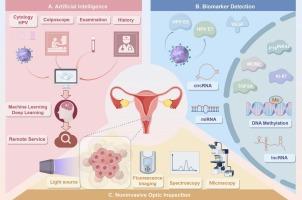宫颈癌筛查的多维技术进步:从标准化流程到精准医学
IF 9.7
1区 医学
Q1 BIOCHEMISTRY & MOLECULAR BIOLOGY
Biochimica et biophysica acta. Reviews on cancer
Pub Date : 2025-08-25
DOI:10.1016/j.bbcan.2025.189432
引用次数: 0
摘要
子宫颈癌是全世界妇女中常见的恶性肿瘤。为了解决这一重大的公共卫生问题,世界卫生组织发起了“消除宫颈癌”倡议。有效的子宫颈癌筛检对降低发病率和死亡率至关重要。随着技术的不断进步,宫颈癌筛查已经从传统的细胞学和人乳头瘤病毒(HPV)检测模式发展到多维、多层次、精准筛查的新时代。本文综合综述了近年来筛查技术的核心进展,包括传统筛查方法的创新、无创光学成像、精准医学视角下的分子诊断,以及人工智能在整个筛查过程中的深度融合与赋能。宫颈液基细胞学结合自动化细胞分选技术和智能全片图像分析,实现了异常细胞的高通量鉴定。HPV和多组生物标志物检测技术的准确性和特异性显著提高,为高危感染患者的准确分诊提供了新的依据。无创宫颈成像技术已经在分子水平上提供了宫颈癌前病变的早期识别,结合了易用性和良好的患者接受度。值得注意的是,人工智能技术正在融入多个筛查流程,利用图像识别、风险评估、辅助诊断和自动化测试流程的横向集成和跨平台能力,成为筛查系统创新的关键驱动力。本文章由计算机程序翻译,如有差异,请以英文原文为准。

Multidimensional technological advances in cervical cancer screening: From standardized processes to precision medicine
Cervical cancer is a common malignancy among women worldwide. To address this significant public health issue, the World Health Organization launched the “Eliminating Cervical Cancer” initiative. Effective screening of cervical cancer is crucial for reducing its morbidity and mortality. With continuous technological advancements, cervical cancer screening has evolved from traditional cytology and human papillomavirus (HPV) testing models to a new era of multidimensional, multilevel, and precise screening. This comprehensive review focuses on the core progress of screening technology in recent years, including the innovation of traditional screening methods, noninvasive optical imaging, molecular diagnosis from the perspective of precision medicine, and the deep integration and empowerment of artificial intelligence in the entire screening process. Cervical liquid-based cytology, combined with automated cell sorting technology and intelligent whole-slide image analysis, has achieved high-throughput identification of abnormal cells. The accuracy and specificity of HPV and multiomic biomarker detection technologies have significantly improved, providing a new basis for the accurate triage of patients with high-risk infections. Noninvasive cervical imaging technology already offers early identification of cervical precancerous lesions at the molecular level, combining ease of use with good patient acceptance. Notably, artificial intelligence technology is being integrated into multiple screening processes, leveraging horizontal integration and cross-platform capabilities in image recognition, risk assessment, auxiliary diagnosis, and automated testing processes, becoming a key driver of innovation in screening systems.
求助全文
通过发布文献求助,成功后即可免费获取论文全文。
去求助
来源期刊

Biochimica et biophysica acta. Reviews on cancer
医学-生化与分子生物学
CiteScore
17.20
自引率
0.00%
发文量
138
审稿时长
33 days
期刊介绍:
Biochimica et Biophysica Acta (BBA) - Reviews on Cancer encompasses the entirety of cancer biology and biochemistry, emphasizing oncogenes and tumor suppressor genes, growth-related cell cycle control signaling, carcinogenesis mechanisms, cell transformation, immunologic control mechanisms, genetics of human (mammalian) cancer, control of cell proliferation, genetic and molecular control of organismic development, rational anti-tumor drug design. It publishes mini-reviews and full reviews.
 求助内容:
求助内容: 应助结果提醒方式:
应助结果提醒方式:


